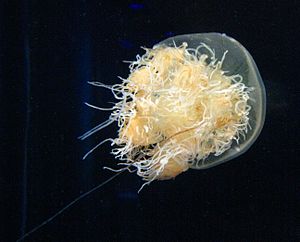Nomura jellyfish
| Nomura jellyfish | ||||||||||||
|---|---|---|---|---|---|---|---|---|---|---|---|---|

|
||||||||||||
| Systematics | ||||||||||||
|
||||||||||||
| Scientific name | ||||||||||||
| Nemopilema nomurai | ||||||||||||
| Kishinouye , 1922 |
Nemopilema nomurai ( Syn . : Stomolophus nomurai ), also Nomura jellyfish , is a very large Japanese jellyfish species. In Japanese it iscalled Echizen kurage (エ チ ゼ ン ク ラ ゲ )after the former Echizen province in Fukui prefecture . It is one of the largest jellyfish known.
features
The Nomura jellyfish can reach a diameter of up to two meters and a weight of up to 200 kilograms. Their tentacles are up to five meters long. It only feeds on plankton .
Occurrence
They occur mainly in the waters between China and Japan , but especially in the Yellow Sea and the East China Sea , where they are believed to multiply. While only a few specimens were sighted in the past, billions of them can now be found off the Japanese and southern Chinese coasts. The reasons for this include overfishing of the seas, global warming and the dirt that is released into the oceans off China's southern coasts. The fact that the larvae ( planular larvae ) of the Nemopilema nomurai develop faster due to these changes is a probable, but still unexplained cause.
Biologists suspect that the number of these giant jellyfish (approx. 20 billion in April 2009) increases exponentially when the jellyfish, which are unwanted during fishing, are first killed by the fishermen and then put back into the water, since almost every female jellyfish has millions of eggs which attach themselves to the sea floor and from which the polyps develop after fertilization .
hazards
In humans, the secretion that they secrete through their stinging cells does not cause serious injuries other than severe pain. However, there have been reports of pulmonary edema (fatal build-up of fluid in the lungs). Because of this, fishermen expecting encounters with these jellyfish wear protective goggles and clothing.
Problems
Annual population increases result in major financial losses in the Japanese fishing industry as the Nomura jellyfish get caught in fishermen's nets. The fish that have already been caught in the nets are crushed by the heavy weight of the jellyfish and sometimes slime and the nets tear under the weight of the jellyfish.
Taxonomy
In 2004, the scientists M. Omori and M. Kitamura suggested using the original name Nemopilema nomurai Kishinouye , in 1922 instead of the more common Stomolophus nomurai , since "echizen kurage is clearly a species of the genus Nemopilema ". Most of the scientific articles have followed this suggestion since then, while the media still speak of Stomolophus nomurai .
Individual evidence
- ^ Photograph of a diver near a Nomura jellyfish , National Geographic
- ^ N24 report from April 16, 2009 Jellyfish
swell
- M. Omori (Akajima Marine Sci. Lab., Okinawa, Japan), M. Kitamura (Tokyo Univ. Fisheries, Tokyo, Japan): Taxonomic review of three Japanese species of edible jellyfish (Scyphozoa: Rhizostomeae) / Plankton Biol. Ecol. 2004, ISSN 1343-0874 , p. 36–51 (For more information, see here .).
Web links
- Giant jellyfish make fishermen desperate. ( Memento from December 27, 2016 in the Internet Archive ), Der Spiegel
- How do you tackle an invasion of giant jellyfish? ( Memento of October 11, 2008 in the Internet Archive ), The Times of London (English)
